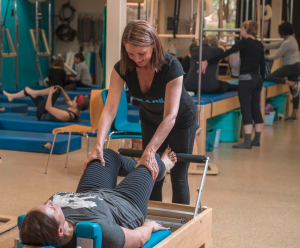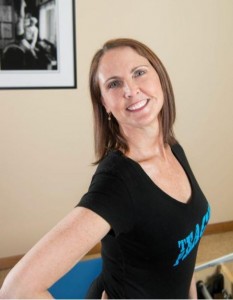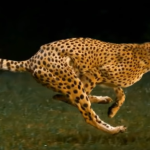Free Your Spine by Moving Like an Animal
by Amy Taylor Alpers
August 21, 2019
“Normal muscles should function naturally in much the same manner as do the muscles of animals.” Joseph Pilates
Mr. Pilates’ writings make it very clear that he wanted normal, natural, whole body movement – that we should move like the animal we are. He tells us that our abdominals (in fact, any muscles) should not be arbitrarily and mechanically contracted and held, but rather be naturally activated through the movement of our whole body – just like an animal does.
We also know that he was very clear about how important a healthy spine is. He wanted you to bend it every possible way – forward, backward, sideways, twist it and roll it. He said “If your spine is inflexibly stiff at 30, you are old. If it is completely flexible at 60, you are young.” Why is this so important though? What difference does a strong, flexible spine actually make to your health? And how do we attain that healthfully?
The human spine is amazing. It is strong and flexible and powerful. It houses and protects the entire spinal cord, and it also includes openings for all the spinal nerves to enter and exit the spine, innervating every system in the body, and sending essential communications to and from the brain.
Each vertebral segment of your spine correlates to a specific area of your body. Therefore, a spine that articulates beautifully and freely – naturally and normally as it was designed to do – releases tension and stimulates and cleanses every organ and system in your body. This is one of the most powerful ways in which Pilates affects the whole body’s health and “returns it to life”. The method is very intentionally designed to move the entire spine in all directions to purposefully affect whole body health.
Tightness, tension, rigidity, fear, weakness, hypermobility, injury, and lack of flexibility at any place in the spine directly and negatively affects whole body health as well. From your brain to your lungs to your colon, from your endocrine to your circulatory to your digestive system – a healthy, flexible spine is the key to your whole body health.
Because of its intricacy and tendency to be damaged by the activities of today’s world, the spine can be scary to work with. Often, Pilates teachers shy away from asking too much of their client’s spinal movement out of fear of injuring them. However, if you truly acknowledge how much a person’s health is directly related to their spine’s powerful flexibility, I am hopeful you will increase your commitment to its essential movement capabilities. Remind yourself that every joint’s movement, or lack thereof, is directly affecting at least one key part of that client’s health.
There are many approaches to help with freeing and moving a client’s spine healthfully. One I often use encourages the client to “relax your spine and use your hands and feet more to ‘move more like an animal.’” My animal of choice for helping clients understand and trust this idea is a wild cheetah. (You can watch a wonderful clip of one here) They are strong, fast, precise, highly coordinated, nimble, flexible, and perfectly – ideally – organized. They never make movement mistakes. If they did – even slightly – they’d hurt themselves.
There is much to learn from watching a cheetah run, but let’s focus specifically on their spine’s freedom to flex, extend, rotate and side-bend freely without any fear or injury – even at top speed. Their life literally depends on it. Why do they not injure themselves? It’s simple, they never do non-cheetah movements. Whereas, sadly, humans do non-natural-human movements all the time – especially sitting in a chair, which uses the spine extremely unnaturally. No wonder it’s damaged.
In Pilates, we often cue our abdominals to support our spine and to initiate the movement. However, ideally, our abdominals should not need to be arbitrarily and mechanically contracted and held. Instead, they should be automatically activated through normal, natural, full body movement. Given our innate design as an originally four-footed animal, this automatic access should naturally occur through the connection of our hands and feet.

Our feet and hands constitute half of all our bones. Given that fact, the number of joints in each is also considerable – several dozen at least – and therefore, the number of muscles and nerves in each, proportionally greater as well. This natural design is a simple way to fully grasp the real value and potential available in utilizing them to their fullest potential as they are designed to be. In other words, the strong connection from brain to hands and feet, and back again, is undeniably essential to our survival and to our health. Just watch the cheetah as she keeps her eyes on the prize and think about what her brain has to be doing as she runs. She lets her brain instantly compute exactly how fast to move her paws and where her paws need to land to achieve her goal.
Now notice how free her spine is to enable just that. If she held her spine or abdominals or spent any energy or brain waves on telling them what to do instead of her feet, she’d most likely trip and fall and hurt herself. Her spine must remain totally free to allow the paws to do their job.
Our human brain and body are designed this way too. Three quarters of the movement cortex of our brains is for controlling our hands and feet. Move them, and allow the rest of the body, especially the spine, to be responsive instead of controlling movement with it, or keeping it too over-controlled by holding it too tightly or strongly. It is in this manner – moving like an animal, using your 4 paws and freeing your spine to be moved accordingly – that Pilates accomplishes its ultimate goals: enhanced and unimpeded breathing; a healthy, flexibly spine; and full body movement that creates no tension in the spine – thereby fully and powerfully cleansing and re-oxygenating the body.
 Amy Taylor Alpers co-founded The Pilates Center (TPC) and The Pilates Center Teacher Training Program (TPCTTP) over 20 years ago in Boulder, Colorado. When not traveling the world to teach both foundational and graduate level Pilates teacher education she remains part of the core faculty for TPCTTP, mentors advanced teachers, teaches classes and sees clients. In addition to teaching TPC sponsored workshops, Amy has presented numerous times at the Pilates Method Alliance Annual Meeting, Balanced Body’s Pilates on Tour and Passing the Torch. In 2013, Amy presented at the Shared Traditions Conference for Fletcher Pilates and will present at The Pilates Roundtable.
Amy Taylor Alpers co-founded The Pilates Center (TPC) and The Pilates Center Teacher Training Program (TPCTTP) over 20 years ago in Boulder, Colorado. When not traveling the world to teach both foundational and graduate level Pilates teacher education she remains part of the core faculty for TPCTTP, mentors advanced teachers, teaches classes and sees clients. In addition to teaching TPC sponsored workshops, Amy has presented numerous times at the Pilates Method Alliance Annual Meeting, Balanced Body’s Pilates on Tour and Passing the Torch. In 2013, Amy presented at the Shared Traditions Conference for Fletcher Pilates and will present at The Pilates Roundtable.
Amy was born in Youngstown, Ohio where she began classical ballet at age two.
She attended The Juilliard School for Dance, danced with the Garden State Ballet in New Jersey, and received a B.A. in Dance and a M.A. in Dance History from New York University. In addition, Amy taught ballet at various dance schools in New York City for ten years before launching her Pilates career.
Both Amy and her sister Rachel studied Pilates under the direct tutelage of Romana Kryzanowska at the original Pilates Studio in New York City. They received their Pilates teaching certificate from there in July of 1989. In 1990, after moving to Boulder, Colorado, Amy and Rachel founded The Pilates Center. The sisters then created and established The Pilates Center Teacher Training Program in 1991. The school has since expanded to include an Intermediate Program, Advanced Program, Bridge Program, Master’s Program, and a Mentorship Program. In addition, TPC now has “Licensed” and “Host” studios established all around the world.
Amy and her sister wrote The Everything Pilates Book, published in 2002. She was a founding board member of the PMA and sat on the board that created the PMA Certification Exam. Recently she has also had the honor of filming classes and workshops for online organizations such as Pilates Anytime and Pilates On Demand.
In 2011, Amy, her sister Rachel, and Ken Endelman of Balanced Body, developed CenterLine – a line of equipment designed for classical Pilates and based upon the specifications pioneered by Joseph Pilates.

